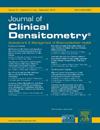Bone health ECHO case report: Normocalcemic hyperparathyroidism in a patient with osteoporosis referred for pre-operative bone health evaluation before spine surgery
IF 1.6
4区 医学
Q4 ENDOCRINOLOGY & METABOLISM
引用次数: 0
Abstract
Primary hyperparathyroidism can be divided into three clinical phenotypes: classical primary hyperparathyroidism with hypercalcemia and target organ involvement, asymptomatic primary hyperparathyroidism with hypercalcemia, and normocalcemic primary hyperparathyroidism. The latter phenotype is being increasingly recognized in patients having serum parathyroid hormone levels measured as part of the initial evaluation of osteoporosis. The diagnosis of normocalcemic primary hyperparathyroidism requires exclusion of secondary causes of parathyroid hormone elevation, such an vitamin D deficiency and calcium malabsorption. There is no consensus on the management of patients with normocalcemic primary hyperparathyroidism, particularly with regard to consideration of parathyroid surgery versus clinical observation. This is a case report of a patient with persistently normal calcium levels, high parathyroid hormone, and no recognized cause of secondary hyperparathyroidism. This case was presented and discussed at Bone Health Extension for Community Healthcare Outcomes, a virtual community of practice that has been meeting online weekly since 2015.
骨健康ECHO病例报告:骨质疏松症患者的正常钙血症甲状旁腺功能亢进在脊柱手术前进行术前骨健康评估
原发性甲状旁腺功能亢进可分为三种临床表型:典型原发性甲状旁腺功能亢进伴高钙血症及累及靶器官、无症状原发性甲状旁腺功能亢进伴高钙血症和正常血钙血症原发性甲状旁腺功能亢进。作为骨质疏松症初步评估的一部分,测量血清甲状旁腺激素水平的患者越来越多地认识到后一种表型。正常血钙水平原发性甲状旁腺功能亢进的诊断需要排除甲状旁腺激素升高的继发原因,如维生素D缺乏和钙吸收不良。对于正常血钙水平的原发性甲状旁腺功能亢进患者的治疗,特别是甲状旁腺手术与临床观察的比较,目前尚无共识。这是一个病例报告的病人持续正常的钙水平,高甲状旁腺激素,继发性甲状旁腺功能亢进没有明确的原因。该病例在骨骼健康扩展社区医疗保健结果上进行了介绍和讨论,这是一个自2015年以来每周在线会议的虚拟实践社区。
本文章由计算机程序翻译,如有差异,请以英文原文为准。
求助全文
约1分钟内获得全文
求助全文
来源期刊

Journal of Clinical Densitometry
医学-内分泌学与代谢
CiteScore
4.90
自引率
8.00%
发文量
92
审稿时长
90 days
期刊介绍:
The Journal is committed to serving ISCD''s mission - the education of heterogenous physician specialties and technologists who are involved in the clinical assessment of skeletal health. The focus of JCD is bone mass measurement, including epidemiology of bone mass, how drugs and diseases alter bone mass, new techniques and quality assurance in bone mass imaging technologies, and bone mass health/economics.
Combining high quality research and review articles with sound, practice-oriented advice, JCD meets the diverse diagnostic and management needs of radiologists, endocrinologists, nephrologists, rheumatologists, gynecologists, family physicians, internists, and technologists whose patients require diagnostic clinical densitometry for therapeutic management.
 求助内容:
求助内容: 应助结果提醒方式:
应助结果提醒方式:


